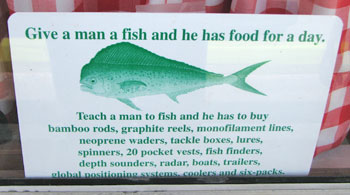I've purchased a copy of
Zooplankton of the Atlantic and Gulf Coasts (A Guide to Their Identification and Ecology) by William S. Johnson and Dennis M. Allen.
While skimming this book I found many useful and informative sections on groups of zooplankton, including fish. Below is an example of the descriptive illustrations found in this book.
Understanding fish larvae is important in Aquaculture, including knowing the proper timing for changing between food sources, as in transferring fish from hatchery to growout ponds. An example can be found in the sidebar, with a list of catfish life stages.

Typical fish egg



Illustrations from Pg. 270, Zooplankton of the Atlantic and Gulf Coasts
Anatomy of larval fishes, based on naked goby Gobiosoma bosc. Middle illustration shows an early feeding stage that has yet to develop fin rays. The last in the series is a juvenile, which is generally defined as a young individual that is fundamentally the same as the adult in morphology.Excerpts from
Zooplankton of the Atlantic and Gulf Coasts, pg. 269-271
"A few species attach sticky eggs to objects at the bottom, but most are simply released into the water column; some are bouyant and some sink to the bottom (demersal eggs). Fish eggs are usually spherical, from 0.5 to 2 mm. The transparency of most of most fish eggs distinguishes them from the typically opaque eggs of invertebrates. Recently spawned eggs have oil droplets or "yolk" that support early development. Development of an embryo is usually rapid, and often within hours of spawning, the outline of the young larva is easily seen within the egg. At hatching, the now-free larva still has a yolk-sac attached to support early development.
The change from the larval planktonic phase to the juvenile and adult lifestyle often involves "remodeling" of the basic larval body plan, resulting in major changes both in morphology and in functional capabilities. The newly hatched yolk sac larvae grow and develop using nutrients provided in the yolk. As the larvae grow, they add musculature, fin rays, and sensory capabilities. Newly hatched larvae are feeble swimmers, but swimming capablities improve rapidly as larvae grow. Some larvae show schooling behavior at a relatively early age. As swimming speed and endurance increase, some larvae show distinctive patterns of vertical migration that may be associated with predator avoidance, feeding migrations, or selective tidal transport. Early larvae are usually transparent with pigmentation increasing during growth.
When the yolk sac is resorbed, the larvae enter the critical "first feeding" stage where they must find and capture prey in the plankton or perish. First foods are quite small; rotifers, ciliates, and copepod nautilii. Vision develops early, and most larval fishes are visual feeders. Prey are perceived at close range, usually within one fish body length... Prey detection and selection seem to be based on prey size more than on any other factor, but motion and color may come into play. Feeding stops in complete darkness but may continue in moonlight. It is interesting that larvae can see in and feed using ultraviolet light, a capability lost in many adults."
Zooplankton of the Atlantic and Gulf Coasts (A Guide to Their Identification and Ecology) by William S. Johnson and Dennis M. Allen is available at amazon.com





















































